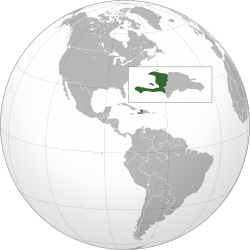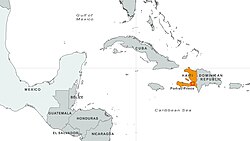Republic of Haiti | |
|---|---|
| Motto: "Liberté, égalité, fraternité" (French) Motto on traditional coat of arms:"Libète, Egalite, Fratènite" (Haitian Creole) "Liberty, Equality, Fraternity" "L'union fait la force" (French) "Inite se fòs" (Haitian Creole) "Union makes strength" | |
| Anthem: La Dessalinienne (French) Desalinyèn (Haitian Creole) "The Dessalines Song" | |
| Capital and largest city | Port-au-Prince 18°35′39″N 72°18′26″W / 18.59417°N 72.30722°W |
| Official languages | |
| Ethnic groups | 95% Black 5% Mixed or White |
| Religion (2020) |
|
| Demonym(s) | Haitian |
| Government | Unitary semi-presidential republic under an interim government |
| |
| Alix Didier Fils-Aimé (acting) | |
| Legislature | National Assembly |
| Senate | |
| Chamber of Deputies | |
| Independence from France | |
Independence declared | 1 January 1804 |
Independence recognized | 17 April 1825 |
| 22 September 1804 | |
| 17 October 1806 | |
| 17 October 1806 | |
| 28 March 1811 | |
| 9 February 1822 | |
Dissolution | 27 February 1844 |
| 26 August 1849 | |
Republic | 15 January 1859 |
| 28 July 1915 – 1 August 1934 | |
Independence from the United States | 15 August 1934 |
| 29 March 1987 | |
| Area | |
Total | 27,750 km2 (10,710 sq mi) (143rd) |
Water (%) | 0.7 |
| Population | |
2023 estimate | 11,470,261 (83rd) |
Density | 382/km2 (989.4/sq mi) (32nd) |
| GDP (PPP) | 2023 estimate |
Total | |
Per capita | |
| GDP (nominal) | 2023 estimate |
Total | |
Per capita | |
| Gini (2023) | medium inequality |
| HDI (2022) | medium (158th) |
| Currency | Gourde (G) (HTG) |
| Time zone | UTC−05:00 (EST) |
Summer (DST) | UTC−04:00 (EDT) |
| Calling code | +509 |
| ISO 3166 code | HT |
| Internet TLD | .ht |
Table of Contents
Introduction to Environmental Regulations in Haiti
Haiti’s journey towards establishing robust environmental regulations has evolved significantly over the past several decades, driven by a combination of historical, social, and ecological factors. The country, rich in biodiversity and natural resources, has faced considerable environmental challenges, including deforestation, soil erosion, and pollution. These challenges underscore the need for effective environmental management to protect both the country’s natural assets and public health.
The historical context of environmental regulations in Haiti can be traced back to the colonial period, when natural resources were exploited with little regard for sustainability or ecological balance. Following independence, environmental policies began to take shape, albeit inconsistently. It wasn’t until the 1990s that a more structured approach emerged, leading to the introduction of formal environmental regulations aimed at controlling and mitigating the adverse effects of human activities on Haiti’s ecosystems.
Today, the legal framework governing environmental issues in Haiti is shaped by a range of laws and regulations that are designed to safeguard the environment. These regulations emphasize the need for sustainable development and aim to integrate environmental considerations into various sectors, including agriculture, mining, and urban planning. Furthermore, the Haitian government, alongside international organizations and NGOs, is actively seeking to enhance the enforcement of these regulations to ensure compliance and facilitate a more sustainable approach to environmental management.
The importance of these environmental regulations cannot be overstated, as they play a critical role in protecting Haiti’s natural resources and maintaining public health. Effective implementation of these regulations is vital not only for the preservation of the country’s biodiversity but also for fostering economic growth and resilience against environmental disasters. Ultimately, a solid environmental regulatory framework is essential for ensuring a sustainable future for Haiti and its people.
Key Environmental Regulations in Haiti
Haiti has implemented various environmental regulations aimed at addressing the pressing challenges associated with natural resource management and environmental degradation. One of the most significant legal frameworks in this context is the Haitian Environmental Law, which was enacted in 1999. This law emphasizes the country’s commitment to protecting its natural environment while promoting sustainable development practices. It provides a comprehensive approach to managing various environmental issues, including deforestation, waste management, and water pollution. The enforcement of this law is critical as it outlines the responsibilities of both governmental bodies and private entities in ensuring compliance.
Another important regulation is the Law on Water and Environmental Protection, which focuses specifically on the management and conservation of water resources. This legislation aims to address the pressing concern of water pollution, promoting sustainable practices and the equitable use of water resources across different regions. It establishes guidelines for wastewater management and outlines penalties for violations to ensure that water bodies remain unpolluted and safe for consumption.
In addition to these laws, the Haitian government has also established environmental impact assessment (EIA) regulations, requiring that any development project undergo a thorough review to evaluate potential environmental effects and mitigation strategies. This step is crucial in ensuring that projects do not result in significant harm to the local ecosystem. Moreover, these regulations help foster a culture of accountability among developers, reinforcing the importance of environmental stewardship in the nation.
Overall, the existing environmental regulations in Haiti are aimed at fostering a delicate balance between economic growth and environmental protection. With these frameworks in place, it is essential for both the government and citizens to remain engaged and proactive in addressing environmental challenges to secure a sustainable future.
Required Environmental Permits
In Haiti, the management and regulation of environmental activities necessitate specific permits that correspond to a variety of industries and actions including construction, industrial operations, and resource extraction. The primary objective of these environmental permits is to ensure that activities comply with national and international environmental standards, minimizing adverse impacts on the ecosystem and public health.
First and foremost, construction projects typically require an environmental impact assessment (EIA) as a preliminary step prior to obtaining a building permit. This assessment analyzes the potential environmental effects of proposed construction and highlights appropriate mitigation measures. Following the EIA, applicants must submit various documentation, such as project plans, site surveys, and as-built designs that adhere to environmental guidelines.
For industrial operations, permits also hinge on obtaining an EIA which evaluates operational emissions, waste management strategies, and potential ecological disruptions. The process demands the submission of an application detailing operational frameworks, machinery to be used, and expected waste outputs. It is critical for businesses to comply with stipulated pollution control mechanisms outlined by the Haitian government to maintain their operational licenses.
Resource extraction activities, including mining or logging, are subject to rigorous control and require extensive documentation. Applicants must submit environmental risk assessments and demonstrate compliance with sustainable practices. These submissions undergo thorough reviews by relevant government agencies, ensuring compliance with national laws and international treaties that Haiti adheres to.
The role of government agencies, particularly the Ministry of the Environment, is central in reviewing applications and issuing these environmental permits. Each permit is subject to scrutiny to ascertain adherence to legal obligations and environmental safeguards. It is imperative for applicants to understand the importance of obtaining the correct environmental permits, as failing to comply can result in significant penalties, including fines or cessation of operations.
Reporting Standards and Compliance Obligations
Businesses and organizations operating in Haiti are subject to various environmental regulations that mandate adherence to specific reporting standards and compliance obligations. These regulations are designed to promote environmental sustainability and safeguard natural resources, ensuring that enterprises minimize their ecological footprint while operating within the framework of the law.
To maintain compliance, companies must submit regular reports to relevant environmental authorities. The frequency of these reports can vary depending on the type of business and the nature of its activities. Typically, companies are required to submit annual reports detailing their environmental impact, including emissions data, waste management practices, and resource consumption metrics. In some cases, more frequent reporting may be mandated for businesses engaged in activities with higher environmental risks.
The types of data required in these reports can be extensive, encompassing a range of environmental indicators. Businesses are often required to provide information on air and water quality, waste generation and disposal methods, and resource usage efficiencies. This data helps authorities monitor compliance with environmental regulations and assess the overall impact of business activities on Haiti’s ecosystems.
In addition to regular reporting, organizations may also be tasked with conducting environmental audits to evaluate their adherence to established standards. These audits serve as a critical tool for ensuring compliance and may be carried out internally or by third-party evaluators. The findings from such audits must also be reported to regulatory bodies, contributing to a transparent and accountable environmental governance framework.
By understanding and fulfilling these reporting standards and compliance obligations, businesses in Haiti can not only comply with legal requirements but also contribute to the stewardship of the environment. In doing so, they enhance their reputation and support sustainable development goals within the nation.
Monitoring and Enforcement Mechanisms
In Haiti, the monitoring and enforcement of environmental regulations are primarily the responsibility of various environmental agencies and local authorities. These entities collaborate to ensure compliance with existing environmental laws and to identify any violations that may occur. The Ministry of Environment is at the forefront of these efforts, tasked with overseeing the implementation of environmental policies and ensuring that regulations are upheld across the nation.
One of the key methods for monitoring compliance involves regular inspections conducted by trained personnel within these agencies. These inspections aim to assess the environmental impact of various activities, including industrial operations, waste management practices, and land use changes. The inspections allow authorities to evaluate adherence to environmental standards, identify potential violations, and recommend corrective actions when necessary. Additionally, local authorities play a crucial role in this process, often acting as the first line of oversight in their respective municipalities.
Reporting mechanisms are also vital in the enforcement of environmental regulations in Haiti. Environmental agencies encourage the public to report any suspected environmental violations, fostering a culture of accountability and transparency. Community engagement is indispensable, as it not only enhances the effectiveness of monitoring efforts but also empowers citizens to participate actively in safeguarding their environment. Local communities can provide valuable insights and observations that may go unnoticed by agencies entirely, making their involvement critical to successful environmental governance.
In summary, the enforcement of environmental regulations in Haiti relies heavily on the coordinated efforts of government agencies and local authorities. Through systematic inspections, effective reporting channels, and active community participation, compliance monitoring can be significantly enhanced, ultimately leading to more sustainable environmental practices in the country.
Penalties for Non-Compliance
The enforcement of environmental regulations in Haiti is crucial to ensure compliance and safeguard the country’s natural resources. Non-compliance with these regulations can lead to a range of serious penalties imposed by the government and relevant authorities. One of the primary consequences for violating environmental laws is the imposition of hefty fines. These financial penalties serve not only to punish offenders but also to deter other individuals or organizations from breaching environmental legislation.
In addition to monetary fines, non-compliance can also result in legal actions against the violators. The Haitian government has the authority to initiate lawsuits against individuals or corporations that disregard environmental regulations. This can lead to civil lawsuits, which may result in additional financial liabilities, or even criminal cases for egregious violations, carrying the risk of imprisonment for responsible parties. Legal action aims to hold perpetrators accountable and enforce adherence to environmental standards.
Furthermore, non-compliance may lead to operational restrictions or the revocation of permits and licenses necessary for conducting certain activities, such as industrial operations, construction, or resource extraction. This can significantly hinder business operations and return on investment as companies may need to halt projects or change their operational practices to meet regulatory demands.
It is essential for businesses and individuals operating in Haiti to be aware of these potential penalties and actively work towards meeting environmental regulations. The ramifications of non-compliance can extend beyond immediate financial consequences; they can also affect a company’s reputation and relationships with stakeholders, including customers, investors, and regulatory bodies. Maintaining a commitment to environmental responsibility is paramount in avoiding these penalties and contributing positively to Haiti’s environmental sustainability.
Best Practices for Compliance
Ensuring compliance with environmental regulations in Haiti requires a proactive approach grounded in best practices. One of the key activities businesses should undertake is conducting thorough environmental assessments. This process helps organizations identify potential environmental impacts related to their operations, allowing them to implement effective mitigation strategies. Regular assessments should be a standard practice, not only during the initial phase of a project but throughout its lifecycle, ensuring ongoing adherence to environmental laws.
Engaging with local communities is another vital practice that organizations must prioritize. By fostering open lines of communication with the communities surrounding their operations, businesses can gain valuable insights into local environmental concerns. Moreover, actively involving community members in discussions about environmental initiatives can enhance trust and collaboration. This relationship not only contributes to compliance but also promotes corporate social responsibility, which is essential in building a sustainable operational framework.
Organizational training is equally important for ensuring compliance with environmental regulations. Providing employees with ongoing education about environmental laws and practices can facilitate a culture of compliance within the organization. Training programs should cover the specifics of local legislation, best practices for waste management, pollution control, and sustainable resource use. By equipping staff with the necessary knowledge and skills, organizations can foster a heightened awareness regarding environmental responsibilities, reducing the likelihood of non-compliance.
In addition to these practices, businesses should also consider developing internal policies that align with environmental regulations, thereby creating a structured approach to compliance. Leveraging technology can further enhance monitoring and reporting processes, ensuring transparency and accountability. By implementing these best practices, organizations in Haiti can significantly improve their compliance with environmental regulations, safeguarding both the environment and their operations.
Case Studies and Examples
In Haiti, environmental regulations are critical for ensuring sustainable development and preserving natural resources. An illustrative case of compliance can be seen in the 2015 rehabilitation project for the La Visite National Park, where multiple stakeholders, including NGOs and government agencies, collaborated to restore degraded areas. Through adherence to environmental regulations, the project successfully implemented best practices for biodiversity conservation, ultimately resulting in improved water quality and increased local fauna. The project’s success stands as an example of how compliance can yield significant ecological benefits, showcasing the importance of following environmental laws.
Conversely, environmental non-compliance can lead to devastating consequences. The case of the mining operations in the Artibonite Valley presents a critical lesson. In this instance, companies failed to comply with environmental assessments, leading to severe soil degradation and pollution of local water sources. The short-term economic gains achieved through unregulated extraction resulted in long-term harm to agriculture and the livelihoods of local communities. This scenario highlights the importance of adhering to established environmental regulations, as the repercussions of non-compliance can extend beyond immediate gains and threaten community welfare.
Another valuable example can be drawn from agricultural practices in the northern regions of Haiti. Farmers who adopted sustainable farming methods compliant with environmental regulations saw a notable increase in crop yields and soil fertility. Programs that promoted the use of organic fertilizers and crop rotation allowed these farmers to mitigate the adverse effects of climate change, demonstrating that compliance with environmental obligations can lead to improved economic resilience. This case further emphasizes that successful environmental regulation in Haiti is not just about compliance but also about promoting innovative practices that enhance sustainability.
Conclusion and Future Outlook
In the context of environmental regulations and compliance in Haiti, several key points have emerged throughout our discussion. Firstly, we have identified that environmental degradation presents substantial challenges to Haiti’s ecological integrity and public health. As a nation, Haiti’s vulnerability to natural disasters exacerbates these issues, making effective environmental governance crucial. The role of legislative frameworks and compliance obligations cannot be overstated, as they provide the necessary structure for sustainable development initiatives. Ensuring adherence to these regulations is vital for the protection of natural resources and the promotion of environmental stewardship among local communities.
Looking forward, several areas for improvement remain evident. Enhancing the capacity of regulatory institutions is paramount for effective enforcement of existing environmental laws. Moreover, raising public awareness and encouraging community involvement in environmental decision-making processes can lead to more robust compliance. A proactive approach that includes public education campaigns, as well as stakeholder engagement, can foster a culture of environmental responsibility. Future legislative changes will likely further strengthen these frameworks, as the global emphasis on sustainability continues to evolve.
Furthermore, collaboration between governmental agencies, non-governmental organizations, and international bodies can enhance the implementation of best practices in environmental management. Such partnerships can facilitate knowledge sharing and resource mobilization, which are essential for addressing the multifaceted environmental challenges Haiti faces. By reinforcing the importance of ecological conservation and sustainable practices, Haiti can work towards improving its environmental landscape.
In conclusion, while the path ahead may be fraught with challenges, a sustained commitment to enhancing environmental regulations and compliance obligations will ultimately contribute to the nation’s resilience and prosperity. Through collective efforts and continuous adaptation to emerging needs, Haiti can forge a brighter future that prioritizes ecological health and community well-being.



